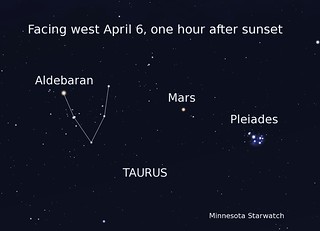Northern Sky: April 13 - 26, 2019
NORTHERN SKY – by DEANE MORRISON
April 13-26 2019
Well, what a difference a day makes. On Wednesday, April 10, a colossal astronomy story broke. Scientists working from radio telescopes all over the world released the first direct image of a black hole. Apologies if you’ve already heard all about this, but here goes.
Black holes are typically found at the centers of galaxies. They concentrate matter so densely, and generate such strong gravity, that nothing that gets too close can escape, including light. The boundary beyond which escape is impossible is called the Event Horizon, and that’s the name of the team that produced the image.
This black hole shows up as a dark round area inside a fuzzy, lopsided doughnut of light. It lies at the heart of a monster galaxy called Messier 87, which is one of the most massive galaxies in a cluster of galaxies in the constellation Virgo. The Virgo Cluster is in the general neighborhood of our Milky Way galaxy, and both the Milky Way and Messier 87 are powered by supermassive black holes.
But there’s no comparison. The mass of the Milky Way’s black hole is equal to 4 million suns, while Messier 87’s black hole has the mass of 6.5 billion suns; that’s 1,600 times more. The researchers calculated the diameter of the black hole to be 40 billion kilometers, or 25 billion miles. That makes it more than four times the diameter of Neptune’s orbit and nearly the size of our entire solar system. The Messier 87 galaxy is about 55 million light-years away. It’s visible through a small telescope, and May is a good month to observe it.
If you want to see where in the sky this galaxy is, and maybe point out its location to children or friends, you can use stars to navigate. Start by facing south after nightfall, at 9:30 or so. You’ll see the constellation Leo, the lion, fairly high in the south. Its brightest star, Regulus, is the point in a backward question mark of stars that outline the lion’s head. Just east of the lion’s head is a triangle of stars marking the tail and hindquarters. The brightest and most eastern of these stars is Denebola. Okay, remember Denebola. Moving eastward again, you’ll see brilliant Arcturus, not quite as high as Denebola. Much lower, between Denebola and Arcturus, is Spica, the brightest star in Virgo.
Put another way, we have brilliant Arcturus well up in the east, Spica far to the lower right of Arcturus, and relatively dim Denebola to the upper right of both. These three stars form a nearly equilateral triangle. In fact, they are often called the Spring Triangle.
If you look from Arcturus about three quarters of the way to Denebola, and then down a little, that’s where M87 and its black hole, its heart of darkness, are. On April 17 the moon visits; if you point to a spot directly west of Arcturus and above the moon, you won’t be far off.
In the morning sky, Jupiter and Saturn, along with the star group known as the Teapot of Sagittarius, are slowly making their way westward, like a convoy. Jupiter is kind of low but brilliant, Saturn is the next bright object to the east, and the Teapot is between them. The moon visits Jupiter on the 23rd; on the 24th it sits right above the lid of the Teapot, and on the 25th it visits Saturn.
April’s full moon arrives on Friday, the 19th at 6:12 a.m. That’s shortly after sunrise and before moonset in Grand Marais. With clear views to east and west, you’ll see a rising sun and a very round, setting moon facing each other from opposite horizons.
Tweet




